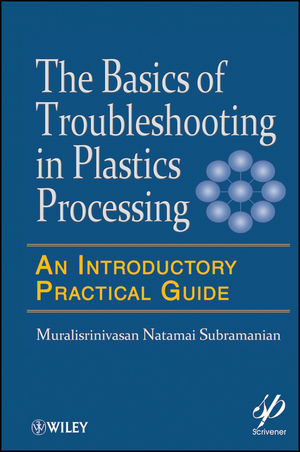Basics of Troubleshooting in Plastics Processing: An Introductory Practical GuideISBN: 978-0-470-62606-1
Hardcover
240 pages
February 2011
 |
||||||
1. Introduction.
1.1 Market Trends.
1.2 Importance of Plastics.
1.3 Plastics Processing.
1.4 Fundamental.
References.
2. Plastics Materials.
2.1 Properties and Processing.
2.2 Polyethylene.
2.3 Polypropylene (PP).
2.4 Polystyrene.
2.5 Polyvinylchloride (PVC).
2.6 Engineering Plastics.
2.7 Advantages.
2.8 Fundamental.
References.
3. Plastics Additives.
3.1 Antioxidants.
3.2 Anti-block Agents.
3.3 Antistatic Agent.
3.4 Clarifying Agents.
3.5 Slip Additives.
3.6 Processing Aids.
3.7 Antifogging Agents.
3.8 Antiblocking Agents.
3.9 Heat Stabilizers.
3.10 Lubricants.
3.11 Plasticizers.
3.12 Coupling Agents or Surface Modifiers.
3.13 Release Agents.
3.14 Flame Retardants.
3.15 Pigments.
3.16 Light Stabilizers.
3.17 Impact Modifiers.
3.18 Blowing Agents.
3.19 Nucleating Agents.
3.20 Biocides.
3.21 Fillers.
3.22 Fundamentals.
References.
4. Plastics Processing.
4.1 Focus on Plastics Processing.
4.2 Injection Molding.
4.3 Extrusion.
4.4 Blow Molding.
4.5 Thermoforming.
4.6 Rotational Molding.
4.7 Fundamental.
References.
5. Troubleshooting – Problems and Solutions.
5.1 Troubleshooting – Requirements.
5.2 Injection Molding – Troubleshooting.
5.3 Troubleshooting – Extrusion.
5.4 Troubleshooting – Blow molding.
5.5 Troubleshooting – Thermoforming.
5.6 Troubleshooting – Rotational molding.
References.
6. Future Trends.
6.1 Productivity.
6.2 Automotive Applications.
6.3 Medical Applications.
6.4 Environmental Issues.
6.5 Fundamentals.
References.
Index.



